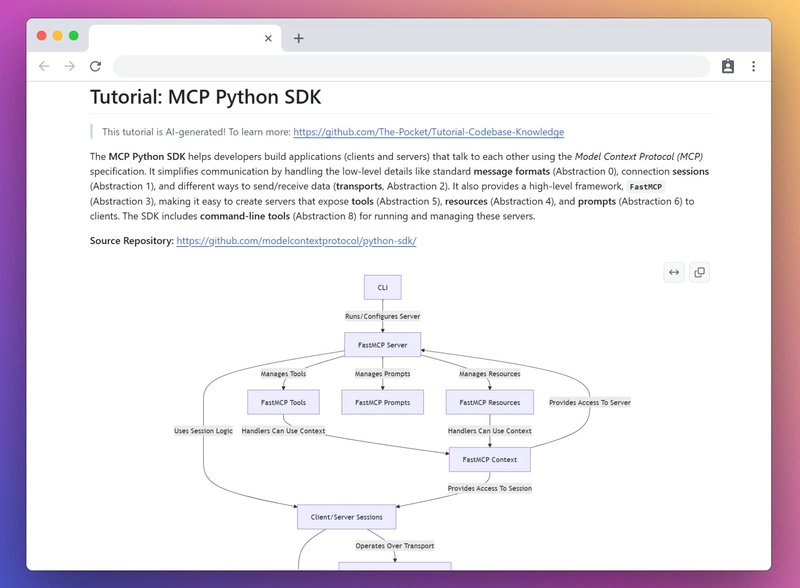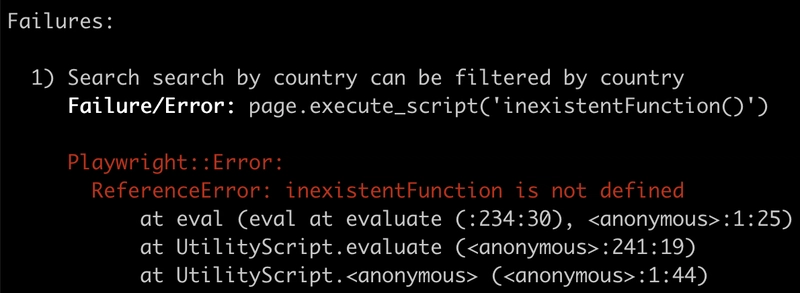AI Codebase Knowledge Builder (Full Dev Tutorial!)
Ever stared at a new codebase feeling completely lost? What if an AI could read it for you and create a friendly tutorial explaining exactly how it works? This guide shows you how to build a system that does exactly that! The AI system is open-sourced on GitHub. 1. Life's too short to stare at others' code in confusion Let's be real: You've just joined a new team or stumbled upon an exciting open-source project. You're pumped to contribute, but when you open the repository... oh boy. Hundreds of files. Thousands of functions. Code that seems to be talking to other code that's talking to who-knows-what. And you're sitting there thinking, "Where the heck do I even begin?" Sound familiar? Don't worry, we've all been there! The Painful Reality of New Codebases Let's cut to the chase: understanding someone else's code is hard. Not just regular hard - it's tear-your-hair-out frustrating. Studies show developers spend up to 60% of their time just trying to understand code rather than writing it. That's weeks or months of your life spent muttering things like: "What the heck does this class actually do?" "How on earth does this component connect to that one?" "Why in the world was it designed this way?" "Can someone please explain the big picture here?!" And the fun doesn't stop there! Documentation is often outdated or—let's be honest—completely non-existent. Comments are as rare as unicorns. Variable names might as well be written in hieroglyphics. It's like being handed a 1000-piece puzzle with half the pieces missing, no picture on the box, and someone saying "Good luck, have fun!" Why Current AI Solutions Fall Short Picture this: You're exploring CrewAI, a cool multi-agent framework. Curious about how it works, you paste some code into ChatGPT and ask "How does CrewAI's multi-agent chat system work internally?" ChatGPT confidently responds: "CrewAI's multi-agent system operates through a structured framework that orchestrates interactions between specialized AI agents. Each agent has a specific role, custom knowledge base, and defined goals. The system includes a central orchestration layer, communication protocols, and context management..." Super helpful, right? ...Nope, not really. Here's why current AI explanations leave you scratching your head: They give you buzzword salad, not actual insights - You get fancy terms like "orchestration layer" and "context management" without any clue what these actually mean in practice They barely scratch the surface - They'll tell you what the code does but never explain why it's designed that way or what problem it's actually solving The end result? Your brain is now swimming with technical jargon, but you still have zero idea how the system actually works. It's like someone handed you all the ingredients for a gourmet cake but forgot the recipe—technically complete but practically useless. Introducing Codebase Knowledge Builder What if there was a better way? A system that could: Devour entire codebases and identify the core ideas and how they play together Transform complicated code into tutorials so clear your grandma could understand them Build your understanding step-by-step from the basics to the advanced stuff in a way that actually makes sense That's exactly what we're building today: a tool that transforms any GitHub repository into a personalized guidebook that actually helps you understand how the code works. This project is open-sourced on GitHub. Check out some example tutorials! AutoGen Core - Build AI teams that talk, think, and solve problems together like coworkers! Flask: Craft web apps with minimal code that scales from prototype to production! MCP Python SDK - Build powerful apps that communicate through an elegant protocol without sweating the details! OpenManus - Build AI agents with digital brains that think, learn, and use tools just like humans do! This project is powered by PocketFlow - a tiny but mighty agent framework that lets us build complex workflows with minimal code. We'll also use Gemini 2.5 Pro, Google's latest AI with serious code-understanding superpowers. Together, they'll create a system that feels almost magical in its ability to make sense of complex code. Whether you're a seasoned dev tired of banging your head against unfamiliar code, a team lead who wants to make onboarding less painful, or just someone curious about AI's potential to make programming more accessible - this tutorial is for you. Let's dive in! 2. From Code Chaos to Crystal Clarity: Our Secret Sauce Code isn't just a collection of functions and variables—it's a carefully designed system of abstractions working together to solve problems. Yet most documentation focuses on individual pieces, missing the forest for the trees. Our Codebase Knowledge Builder takes a fundamentally different approach. From Confusion to Clarity: Our Two-Step Magic Trick Here's t

Ever stared at a new codebase feeling completely lost? What if an AI could read it for you and create a friendly tutorial explaining exactly how it works? This guide shows you how to build a system that does exactly that! The AI system is open-sourced on GitHub.
1. Life's too short to stare at others' code in confusion
Let's be real: You've just joined a new team or stumbled upon an exciting open-source project. You're pumped to contribute, but when you open the repository... oh boy. Hundreds of files. Thousands of functions. Code that seems to be talking to other code that's talking to who-knows-what. And you're sitting there thinking, "Where the heck do I even begin?"
Sound familiar? Don't worry, we've all been there!
The Painful Reality of New Codebases
Let's cut to the chase: understanding someone else's code is hard. Not just regular hard - it's tear-your-hair-out frustrating. Studies show developers spend up to 60% of their time just trying to understand code rather than writing it. That's weeks or months of your life spent muttering things like:
- "What the heck does this class actually do?"
- "How on earth does this component connect to that one?"
- "Why in the world was it designed this way?"
- "Can someone please explain the big picture here?!"
And the fun doesn't stop there! Documentation is often outdated or—let's be honest—completely non-existent. Comments are as rare as unicorns. Variable names might as well be written in hieroglyphics. It's like being handed a 1000-piece puzzle with half the pieces missing, no picture on the box, and someone saying "Good luck, have fun!"
Why Current AI Solutions Fall Short
Picture this: You're exploring CrewAI, a cool multi-agent framework. Curious about how it works, you paste some code into ChatGPT and ask "How does CrewAI's multi-agent chat system work internally?"
ChatGPT confidently responds:
"CrewAI's multi-agent system operates through a structured framework that orchestrates interactions between specialized AI agents. Each agent has a specific role, custom knowledge base, and defined goals. The system includes a central orchestration layer, communication protocols, and context management..."
Super helpful, right? ...Nope, not really. Here's why current AI explanations leave you scratching your head:
- They give you buzzword salad, not actual insights - You get fancy terms like "orchestration layer" and "context management" without any clue what these actually mean in practice
- They barely scratch the surface - They'll tell you what the code does but never explain why it's designed that way or what problem it's actually solving
The end result? Your brain is now swimming with technical jargon, but you still have zero idea how the system actually works. It's like someone handed you all the ingredients for a gourmet cake but forgot the recipe—technically complete but practically useless.
Introducing Codebase Knowledge Builder
What if there was a better way? A system that could:
- Devour entire codebases and identify the core ideas and how they play together
- Transform complicated code into tutorials so clear your grandma could understand them
- Build your understanding step-by-step from the basics to the advanced stuff in a way that actually makes sense
That's exactly what we're building today: a tool that transforms any GitHub repository into a personalized guidebook that actually helps you understand how the code works. This project is open-sourced on GitHub.
Check out some example tutorials!
AutoGen Core - Build AI teams that talk, think, and solve problems together like coworkers!
Flask: Craft web apps with minimal code that scales from prototype to production!
MCP Python SDK - Build powerful apps that communicate through an elegant protocol without sweating the details!
OpenManus - Build AI agents with digital brains that think, learn, and use tools just like humans do!
This project is powered by PocketFlow - a tiny but mighty agent framework that lets us build complex workflows with minimal code. We'll also use Gemini 2.5 Pro, Google's latest AI with serious code-understanding superpowers. Together, they'll create a system that feels almost magical in its ability to make sense of complex code.
Whether you're a seasoned dev tired of banging your head against unfamiliar code, a team lead who wants to make onboarding less painful, or just someone curious about AI's potential to make programming more accessible - this tutorial is for you. Let's dive in!
2. From Code Chaos to Crystal Clarity: Our Secret Sauce
Code isn't just a collection of functions and variables—it's a carefully designed system of abstractions working together to solve problems. Yet most documentation focuses on individual pieces, missing the forest for the trees. Our Codebase Knowledge Builder takes a fundamentally different approach.
From Confusion to Clarity: Our Two-Step Magic Trick
Here's the thing about understanding code: knowing what each function does is like knowing the names of all the parts in a car engine—utterly useless if you don't know how they work together to make the car move!
What you actually need is:
- The big-picture blueprint (what are the key pieces?)
- The master plan (why was it built this way?)
- The relationship map (how do these pieces talk to each other?)
Our approach mirrors how your brain naturally learns—and it's dead simple:
The Eagle's View - First, we zoom out and see the entire forest: What's this code trying to do? What are the key pieces? How do they fit together? This mental map is your secret weapon against code confusion.
The Deep Dive - Then we swoop in on each important piece: How does it work? What clever tricks does it use? Why was it built this way? We explore thoroughly but always keep its place in your mental map crystal clear.
This is exactly how the best teachers work—they don't drown you in details from day one. They give you the big picture first, then fill in the juicy details in a way that actually makes sense and sticks in your brain.
From Huh? to Aha!: Let's See This Magic in Action
Let's take Flask—that super popular Python web framework—and see how our approach transforms it from cryptic code into crystal-clear concepts:
Step 1: The Eagle's View












































































































































































![[The AI Show Episode 142]: ChatGPT’s New Image Generator, Studio Ghibli Craze and Backlash, Gemini 2.5, OpenAI Academy, 4o Updates, Vibe Marketing & xAI Acquires X](https://www.marketingaiinstitute.com/hubfs/ep%20142%20cover.png)




























































































































![[DEALS] The Premium Learn to Code Certification Bundle (97% off) & Other Deals Up To 98% Off – Offers End Soon!](https://www.javacodegeeks.com/wp-content/uploads/2012/12/jcg-logo.jpg)

![From drop-out to software architect with Jason Lengstorf [Podcast #167]](https://cdn.hashnode.com/res/hashnode/image/upload/v1743796461357/f3d19cd7-e6f5-4d7c-8bfc-eb974bc8da68.png?#)








































































































.png?#)


































_Christophe_Coat_Alamy.jpg?#)


.webp?#)





































































































![Apple Considers Delaying Smart Home Hub Until 2026 [Gurman]](https://www.iclarified.com/images/news/96946/96946/96946-640.jpg)
![iPhone 17 Pro Won't Feature Two-Toned Back [Gurman]](https://www.iclarified.com/images/news/96944/96944/96944-640.jpg)
![Tariffs Threaten Apple's $999 iPhone Price Point in the U.S. [Gurman]](https://www.iclarified.com/images/news/96943/96943/96943-640.jpg)





































































































































